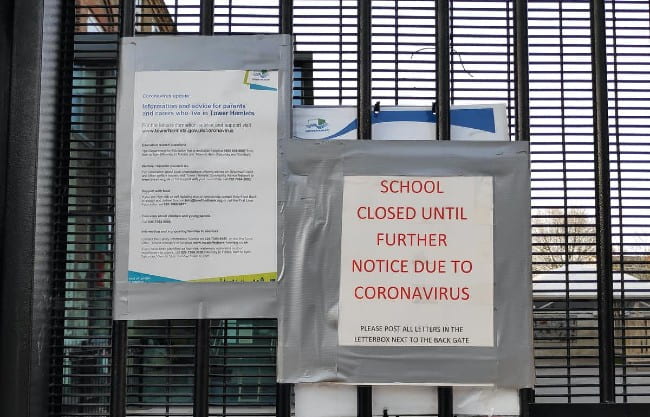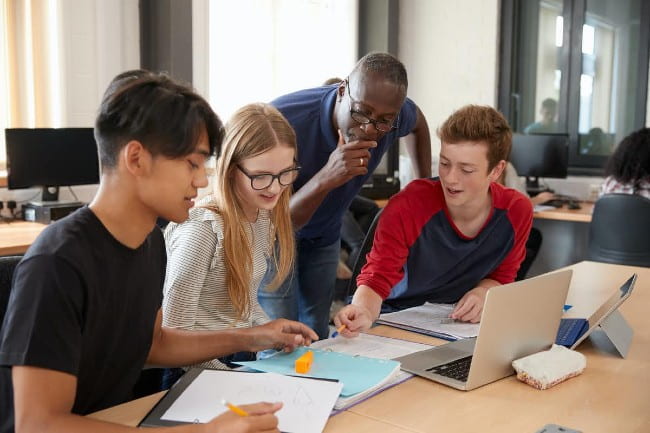Authors:
Simon Burgess, Professor of Economics, University of Bristol
Hans Sievertsen, Senior Lecturer in Economics, University of Bristol
UNESCO estimates that around 1.5 billion children were unable to attend school in the spring of 2020. Closed schools mean lost learning, lower skills and reduced life chances and wellbeing.
A strategy for closing this learning gap needs to be rapid, school-based rather than online, and provided in addition to regular school. Given the size of the learning gap, it requires significant investment. Most importantly, there must be evidence of its effectiveness.
The policy that best fits these criteria is small-group tutoring, based in schools. This is the focus of the UK government’s new flagship catch-up programme, available to state schools in England.
Unequal outcomes
Education losses would be less serious if families had been able to compensate for school closures with effective home learning, but this requires at least a quiet study space and a person that can help. Unsurprisingly, access to such environments is highly unequal.
The early evidence backed this up, showing both general learning loss and that the effect is greatest in disadvantaged households.
 A school in London closed due to the COVID-19 pandemic. Kam Hus/Shutterstock
A school in London closed due to the COVID-19 pandemic. Kam Hus/ShutterstockNow children are back in school, researchers can start to measure the loss of learning. A study in the Netherlands estimates that students lost a fifth of a year of schooling. Evidence suggests that the losses in England are also dramatic.
In June, the UK government announced a £1 billion COVID-19 “catch-up” package, intended to address this loss of learning. Since then, a new institutional framework has been rapidly created to implement this proposal: the National Tutoring Programme.
Of the £1 billion, the government is distributing £650 million directly to schools to help with catch-up as schools see fit, though the government strongly recommends spending it on small-group tutoring. The remaining £350 million goes straight to the NTP. Their progamme has two components: funding in-school academic mentors to provide intensive support, and providing subsidised access to tuition partners – existing tuition organisations. Both parts focus on disadvantaged children.
Catching up
Implementing a tutoring system at scale is challenging. It requires recruitment, training, and the quality assurance of a large number of tutors, and it must ensure that the tutoring reaches those who need it.
The National Tutoring Programme has chosen to adopt a “platform service” model to meet these challenges. The platform allows for customers – schools – to be matched with suppliers – tutoring organisations.
Last week we announced the 32 organisations selected to be NTP Tuition Partners. They will deliver subsidised tutoring to schools across England to support disadvantaged pupils whose learning has been most affected by the pandemic.
Read more here: https://t.co/d0ezCyZA3U pic.twitter.com/m68nrsOKt0
— National Tutoring Programme (@NTProgramme) November 9, 2020
It is very likely that the tutoring itself will raise skills: small group tutoring has been shown to be an effective method to help students who need extra support.
The question is whether the organisational form chosen to deliver this at large scale will work. There are good reasons for the approach chosen – but we do have some concerns.
First, it is vital that there is a strong link between the quality of a tutor organisation and the subsequent demand for its services. Unlike an organisation like Airbnb, local competition and repeated transactions might be too low to provide this link for a tutoring service.
The reliability of an accommodation option on Airbnb comes from the multiple, frequent reviews from a wide range of visitors. That kind of review base will not be available for a while. Furthermore, developing appropriate metrics for quality assurance will also take time. There will probably still be a need for bureaucratic quality review.

Second, what are the incentives for schools when they are thinking about purchasing and distributing tutoring time? For example, with free tutoring on offer, it seems likely (and understandable) that there will be pressure from some parents for their children to access the tutoring. However, it is also quite likely that these parents are not necessarily the parents of the children who most need it.
And then there is the sheer scale of the problem being addressed. In England, around 7 million children were in school before the first national lockdown and have been potentially affected by learning loss as a result of the pandemic.
This scale is too much for the current setup and current budget to address in full, meaning that many children will not achieve the skill levels that they might have hoped to at the end of their schooling. While £1 billion is a lot of money, dealing with this crisis fully will need more.
Indeed, while the National Tutoring Programme is among the first responses around the world to the pandemic learning loss, others suggest even greater action: in the US, leading educational researcher Robert Slavin has called for a large-scale “Tutoring Marshall Plan” to help heal the lost learning there.
While these issues must be kept under review, the National Tutoring Programme is undoubtedly a welcome initial response to the potentially enormous problem of lost skills in England.
This article has been amended to correct details of how the government’s catch-up funding is being spent.
This article is republished from The Conversation under a Creative Commons license, Read the original article.
